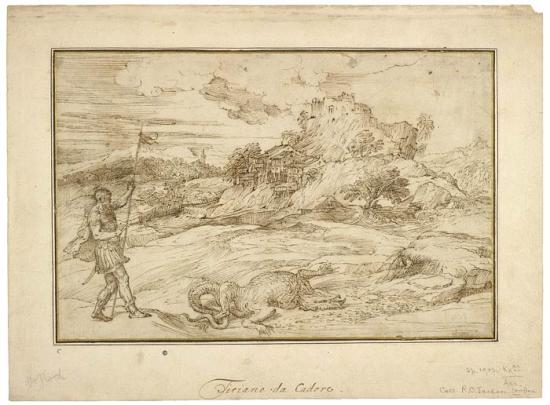
Landscape with St. Theodore Overcoming the Dragon
Inscribed on old mount at center, beneath the drawing, in pen and brown ink, Titiano da Cadore.
Gift of János Scholz, 1977
Arguably the greatest of all Venetian painters, Titian was held in high esteem during his lifetime. His paintings and drawings were as novel in subject matter and composition as they were bold in technique. St. Theodore Overcoming the Dragon is one of the rare landscape drawings attributed to the artist.
Theodore, one of the patron saints of Venice, did not slay the dragon but instead made it roll over in submission. The figure seated under the tree in the background may be the mother who, according to legend, brought her ailing child to be bathed in a miraculous well guarded by the dragon.
Landscape and Pastoral
Today Venice evokes images of a picturesque city rising from the sea. Yet sixteenth-century Venetian artists rarely depicted the lagoon or its atmospheric effects. Instead they documented alpine vistas or created fantastical scenes. Landscape was such an important element of fifteenth- and sixteenth-century Venetian painting and drawing that it often dominated even works with mythological or religious subjects. This trend was very much in keeping with the strong interest in the natural world that emerged during the Renaissance, when many artists began to rely on direct observation rather than inherited models. Inspired by the works of the ancient poet Virgil, Venetian humanists extolled the simplicity of pastoral life, and writers, composers, and artists alike embraced Arcadian themes of love, poetry, and music.
